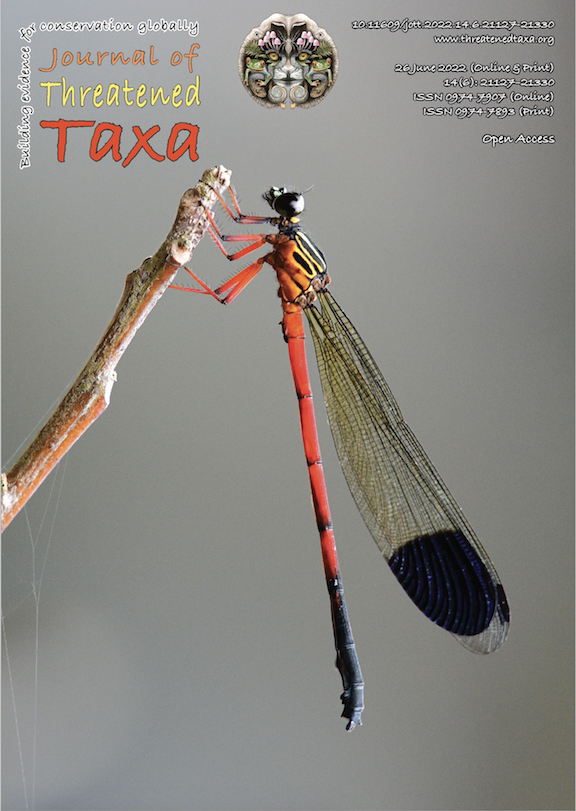First report of the termite Glyptotermes ceylonicus (Blattodea: Isoptera: Kalotermitidae) from India: an example of discontinuous distribution
DOI:
https://doi.org/10.11609/jott.4715.14.6.21290-21295Keywords:
Dichotomous key, diversity, endemism, southern IndiaAbstract
We report Glyptotermes ceylonicus (Holmgren, 1911), an endemic Sri Lankan termite, for the first time from India. Glyptotermes show a high degree of endemism throughout the world. Record of this species from the current location indicates a wide distribution of this species in southern India, in the past, before the complete separation of Sri Lanka from India. The current distribution of Glyptotermes ceylonicus is also an example of discontinuous distribution. Pictorial illustrations of the morphologically important parts and revised key for the Indian species are provided.
References
Amina, P. & K. Rajmohana (2016). Glyptotermes chiraharitae n. sp., a new dampwood termite species (Isoptera: Kalotermitidae) from India. Zoosystema 38(3): 309–316. https://doi.org/10.5252/z2016n3a2
Amina, P., K. Rajmohana, C. Bijoy, C. Radhakrishnan & N. Saha (2013). First record of the Srilankan Processional Termite, Hospitalitermes monoceros (Konig) (Termitidae: Nasutitermitinae) from India. Halteres 4: 48–52.
Basu, P., E. Blanchart & M. Lepage (1996). Termite (Isoptera) community in the Western Ghats, South India: influence of anthropogenic disturbance of natural vegetation. European Journal of Soil Biology 32(3): 113–21.
Briggs, J.C. (2003). The biogeographic and tectonic history of India. Journal of Biogeography 30: 381–388. https://doi.org/10.1046/j.1365-2699.2003.00809.x
Chhotani, O.B. (1970). Revision of the genus Glyptotermes Froggatt (Kalotermitidae, Isoptera, Insecta) from the Indian Region. Records of the Zoological Survey of India 68(1/4): 109–159.
Emerson, A.E. (1952). The Neotropical genera Procornitermes and Cornitermes (Isoptera, Termitidae). Bulletin of the American Museum of Natural History 99(8): 475–539.
Emerson, A.E. (1955). Geographical origins and dispersions of termite genera. Fieldiana: Zoology 37: 465–521. https://doi.org/10.5962/bhl.title.2783
Froggatt W.W. (1897). Australian Termitidae. Part II. Proceedings of the Linnean Society of New South Wales 21: 510–552. https://doi.org/10.5962/bhl.part.8483
Hemachandra, I.I., J.P. Edirisinghe, W.A.I.P.A. Karunaratne & C.V.S. Gunetilleke (2012). An annotated checklist of termites (Isoptera) of Sri Lanka.MAB Checklist and Handbook Series Publication No. 24. National Science Foundation of Sri Lanka, Colombo, 29 pp.
Holmgren, N. (1911). Ceylon-Termite gesammelt von Prof. K. Escherisch, nebste iner synoptischen tibersicht tiber aIle bisjetzt von Ceylon und den angrenzenden Festland bekannten Termitenarten, pp. 183–212. In: Termiten lebena Uf Ceylon, u.s. w. (by K. Escherisch). Systematischer Anhang: Termiten und Termitophilen von Ceylon.
Inward, D. J., A.P. Vogler & P. Eggleton (2007). A comprehensive phylogenetic analysis of termites (Isoptera) illuminates key aspects of their evolutionary biology. Molecular phylogenetics and evolution 44(3): 953–967.
Krishna, K., D.A. Grimaldi, V. Krishna & M.S. Engel (2013).Treatise on the Isoptera of the world. Bulletin of the American Museum of Natural History B377(1): 2282–2310. https://digitallibrary.amnh. org/handle/2246/6430
Krutzsch, W. (1989). Paleogeography and historical phytogeography (paleochorology) in the Neophyticum. Plant Systematics and Evolution 162: 5–61. https://doi.org/10.1007/BF00936909
Mathew, J. & C. Ipe (2018). New species of termite Pericapritermes travancorensis sp. nov. (Isoptera: Termitidae: Termitinae) from India. Journal of Threatened Taxa 10(11): 12582–12588. https://doi.org/10.11609/jott.3389.10.11.12582-12588
Mcloughlin, S. (2001). The breakup history of Gondwana and its impact on pre-Cenozoic floristic provincialism. Australian Journal of Botany 48: 271–300. https://doi.org/10.1071/BT00023
Partridge, T.C. (1997). Late Neogene uplift in eastern and southern Africa and its paleoclimatic implications, pp. 63–86. In: Ruddiman, W.F. (eds.). Tectonic Uplift and Climate Change. Springer, Boston, xxi+535 pp. https://doi.org/10.1007/978-1-4615-5935-1_4
Rohr, D.M., J. Boucot, A.J. Miller & M. Abbott (1986). Oldest termite nest from the Upper Cretaceous of west Texas. Geology (Boulder) 14(1): 87–88. https://doi.org/10.1130/0091-7613(1986)14<87:OTNFTU>2.0.CO;2
Roonwal, M.L. & O. B. Chhotani (1989). The Fauna of India and the Adjacent Countries: Isoptera (Termites) - Vol. 1. Zoological Survey of India, Calcutta, 672 pp.
Sands, W.A. (1998). The Identification of Worker Castes of Termite Genera from Soils of Africa and the Middle East. CAB International, Wallingford, 500 pp. https://doi.org/10.1017/S0007485399000413
Sengupta, R., K. Rajmohana, A. Poovoli, J. Basak & B. Baraik (2019). Revalidation of the presence of Glyptotermes brevicaudatus (Haviland) and Glyptotermes caudomunitus Kemner in India (Isoptera: Kalotermitidae). Oriental Insects 53(4): 588–598.
Thakur, R.K., T. Vivek & K. Sachin (2010). Glyptotermes roonwali (Isoptera: Kalotermitidae), a new species from India. Entomon 35(2): 111–119.
Wasmann, E. (1902). Termiten, Termitophilen und MyrmekophiIen, gesammelt auf Ceylon von Dr W Horn, 1899, mitandernostindischen Material bearbeitet. Beitragezur Kenntnis der Myrmekophilen und der Termitophilen. Zoologische Jahrbücher (Syst.) 17(1): 99–164.
Willis, J.K. & J.C. Mcelwain (2002). The evolution of plants. Annals of Botany 90(5): 678–679. https://doi.org/10.1093/aob/mcf232
Published
Versions
- 26-06-2022 (2)
- 26-06-2022 (1)
Issue
Section
License
Copyright (c) 2022 Edwin Joseph, Chinnu Ipe, Nisha P. Aravind, Sherin Antony, Jobin Mathew

This work is licensed under a Creative Commons Attribution 4.0 International License.
Authors own the copyright to the articles published in JoTT. This is indicated explicitly in each publication. The authors grant permission to the publisher Wildlife Information Liaison Development (WILD) Society to publish the article in the Journal of Threatened Taxa. The authors recognize WILD as the original publisher, and to sell hard copies of the Journal and article to any buyer. JoTT is registered under the Creative Commons Attribution 4.0 International License (CC BY), which allows authors to retain copyright ownership. Under this license the authors allow anyone to download, cite, use the data, modify, reprint, copy and distribute provided the authors and source of publication are credited through appropriate citations (e.g., Son et al. (2016). Bats (Mammalia: Chiroptera) of the southeastern Truong Son Mountains, Quang Ngai Province, Vietnam. Journal of Threatened Taxa 8(7): 8953–8969. https://doi.org/10.11609/jott.2785.8.7.8953-8969). Users of the data do not require specific permission from the authors or the publisher.





